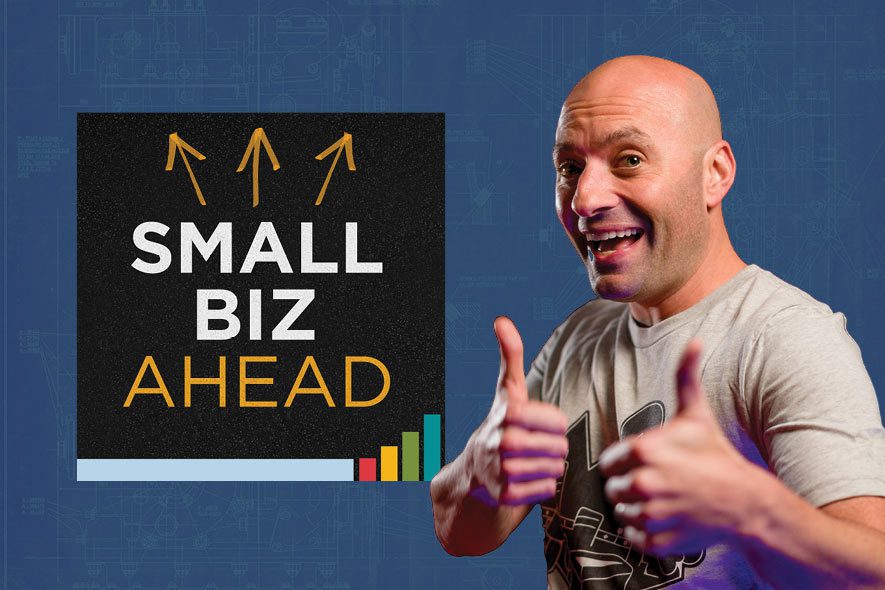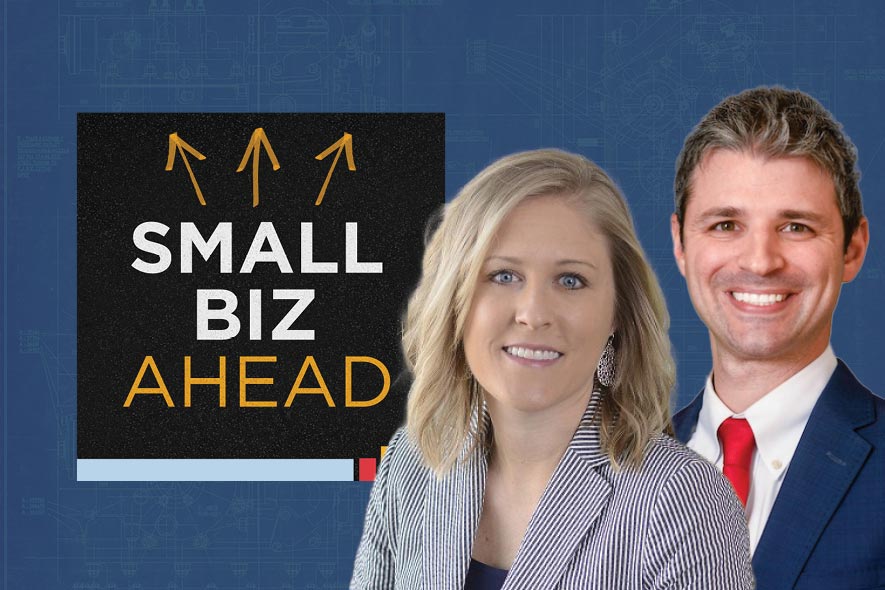Listen now to the latest episode of the Small Biz Ahead Podcast:
Welcome to another episode of the Small Biz Ahead Podcast. Sign up for the weekly newsletter so you never miss an episode.
Links
Elizabeth: All right. We’re back this week with two new great questions. The first one is about growing your customer base, and the second one is about dumping troublesome clients. Sounds very good. Gene, how are you doing this week?
Gene: I am doing very well. I’m happy to be speaking with you, Elizabeth.
Elizabeth: I’m happy to be speaking with you. Any new things going on in your life right now?
Gene: Nothing of huge interest, although we’re planning a trip to Australia, my wife and I.
Elizabeth: Wow.
Gene: Yes, my daughter is studying over there.
Elizabeth: Great.
Gene: We’re trying to figure out, and I’m freaking out, because we have to take a 14 hour plane flight from Los Angeles to Brisbane. I’ve never been on a plane for that long.
Elizabeth: Wow. Will you bring work on the plane, or will you zone out?
Gene: I am going to bring a bottle of Jack Daniels with me on the plane.
Elizabeth: Are you not a good flier?
Gene: No, no. I can fly fine, but I just don’t know what to do for 14 hours in a plane. My plan is to drink and watch a lot of TV.
Elizabeth: Yep, yep. You’re a “Walking Dead” fan, right?
Gene: Yes, huge, huge. I’m all caught up on that, but long flights I think are a good time where you can download stuff and watch on your computer, but it’s expensive. To go buy entire seasons of stuff, it’s like 30 bucks or 40 bucks to do that. Jeez.
Elizabeth: Oh my gosh. I know, I know. It’s crazy.
Gene: It is.
Elizabeth: All right, we’re going to jump into it with question one right after we hear from our sponsor.
Okay, we’re back with question one, and it is from Abigail I. in Austin, Texas.
Gene: Austin, Texas. Okay.
Elizabeth: Austin, Texas.
Gene: What does Abigail do?
Elizabeth: She runs a thriving tattoo parlor.
Gene: Really?
Elizabeth: She says-
Gene: Do you have any tattoos?
Elizabeth: No, I don’t.
Gene: Have you ever thought of getting one?
Elizabeth: No, not really. What about you?
Gene: Never. God, I always felt like getting a tattoo was a huge lifetime decision. You see a lot of people in their 20s or whatever and they get tattoos, and you’re like, “Dude, no offense, but that tattoo when you’re 22 is not going to look the same when you’re 72, but okay.” Plus they hurt a lot as well.
Elizabeth: Yeah, I’m not good with pain.
Gene: Yeah, I try to avoid pain where I can, not pay somebody to inflict pain. [inaudible 00:02:16] is this Abigail? What’s her name again? It’s Abigail, right?
Elizabeth: Abigail I.
QUESTION #1: Growing Your Customer Base without Annoying Your Old Customers
Gene: Yeah, okay. All right. What’s up with Abigail?
I run a thriving tattoo parlor, but I want to know how do I grow my customer base without alienating my old customers or annoying my prospects?
Elizabeth: My answer to that is a CRM system.
Gene: That’s an interesting answer. By golly, my company sells CRM systems. Thank you, Elizabeth.
Elizabeth: I knew you might like that. A CRM system is a customer relationship management system. What that does is it allows you to just communicate with your customers, but you can split them any way you want. You can have an email list that goes out to your old customers or your new customers, or people that you haven’t seen in two years, and you want to remind them to come in. It’s a great way to really serve a lot of different parts of your customer base. Gene, I’m going to let you take this one, run with it.
Gene: You know what it is CRM systems does with our … It’s just a database, okay? That’s all it is. Most of them today are in the cloud. There are many great CRM systems out there. A lot of people know salesforce.com. They’re expensive, but then Microsoft’s got one that’s very good. Zoho CRM, Insightly is very, very good, Sugar, Sage, there’s a bunch of great-
Elizabeth: Are there any free ones in there?
Gene: Good question. A lot of them have free trial versions or free versions for one user, for example. Some of them offer free versions with just less features and functionality to them to kind of get you into them. I’ll tell you Insightly, for example, is 12 bucks a month.
Elizabeth: That’s totally worth it.
Gene: Yeah, it’s so inexpensive, and what these systems do, and Abigail, I promise you I’m going to connect this to what you’re trying to do, it’s a database and it’s online. What you do is you put into that database anybody who touches your business, Abigail. Anybody who walks into your tattoo parlor, you want to make sure that you get their contact information down. Maybe you offer that they’re part of a VIP list to get special mailings or communications or a discount on a future tattoo, if you’re crazy enough to get more tattoos. At least they can be on your VIP list. You’re trying to get data from your customers that come in.
Have I ever told you this, Elizabeth? Near me there’s this Japanese restaurant that my wife and I have gone to for years and years and years, because we have sushi every Friday night or whatever.
Elizabeth: Love it.
Gene: Yeah. This Japanese restaurant last Christmas sent us a fruit basket.
Elizabeth: You’re a very big customer.
Gene: The Japanese restaurant that sent us this fruit basket, they have a little CRM system. They use Act. Act has been around for a million years. A lot of people I’m sure would recognize it, but it’s connected into their phone system. Whenever I call this Japanese restaurant and I order food, it’s always on Friday sometime in the late afternoon, early evening, it pops up my information right on their screen. They know exactly who I am. It’s the last order that I made as well.
They’re always like, “Same order as last time?” I’m always like, “Same order, same order.” They’re very nice people. I can’t understand a word they’re saying, so I’m like just, “Yes, same order, same order, same order.” They’re always great. Then I’m on their VIP list, so I get an email from them once a month, a free California roll with a glass of wine or whatever. It’s very cool. Then my birthday was a couple months ago. I got a birthday email. I don’t even get a birthday email from my kids, and this Japanese restaurant is sending me a birthday email.
Abigail, who has that tattoo parlor, Abigail, your customers are … There’s a niche. These are people that are into tattoos, so it’s a community. I’ve got news for you. They’d like to keep hearing from you over time. What a CRM system will do is it’ll make sure that, first of all, nobody falls through the cracks. Anybody that comes into your store, Abigail, you’re going to have a plan for reaching out to those people. Maybe it’s a once a quarter email that you can use with an email service, like Constant Contact or MIAMA or MailChimp, where it’s some great new designs for tattoos, or tips for doing tattoos, something to educate them about proper cleaning of … I don’t know. Do you have to clean your tattoo? How to avoid infections when you get a tattoo. What do I know? I have no idea what I’m talking about when it comes to tattoos.
Elizabeth: Or new tattoo art.
Gene: Yeah, new tattoo art. That’s exactly right. You have stuff with your tattoo. you can be communicating and making sure no … If a person comes in and gets a tattoo from you, Abigail, that person clearly likes getting tattoos.
Elizabeth: They’re committed, too.
Gene: They’re committed, so are you not reaching out to them maybe a few months later? How do you like the tattoo? Would you like to come back in again? I’ve got a new design that I think you might like or something that’s compliment … Your CRM system will do that for you.
The other thing a CRM system will do, besides making sure nothing falls through the cracks, is it will make sure, Abigail, that you do not look like a dope. If a customer calls you and you pick up the phone or get an email, and you immediately know in the CRM, “Oh yeah, that was the guy that I did the big fish on his back or whatever. He was the guy with the hair back, and I had to shave his hair, and it was disgusting,” or whatever you have to remember, he’s in your CRM system so you don’t look like a dope. You remember your customers.
The other thing with a CRM system, besides reaching out to prospects or existing customers, is it builds value in your business. If one day, Abigail, you decide to get out of the tattoo business and get into something more traditional, like a book store is very nice, that’s a nice little business, but okay. You want to get out of the tattoo business for whatever your reason. You sell the business. If I were to go in … Okay, it wouldn’t be me. If Elizabeth were to go in and buy your tattoo business from you, and you said to her, “Hey, Elizabeth, not only do you get my store and all the equipment and all the whatever, I got this CRM database. Everybody that’s been in here in the past five years and everybody that’s shown an interest in tattoos, he’s my whole what it’s doing to reach out to people.” Elizabeth will pay you more for that.
Elizabeth: Oh, definitely. That’s, I think, the most important part.
Gene: Huge, it’s huge. Oh my God, these are your whole customers and community, and you’re giving it to me.
Elizabeth: Yeah, more than the equipment, more than the space, unless you own it. Yeah, the CRM system, that data is the most important thing.
Gene: It really is. Yes, thank you for suggesting that, Elizabeth. A CRM is exactly what somebody like Abigail would need.
Elizabeth: But the CRM system is only as good as the information you put into it.
Gene: God, that’s so true.
Elizabeth: It really needs to become part of your culture. I’m assuming you probably have at least one other employee, but it needs to become part of your company culture for yourself and your maybe one other employee to put everything possible into that CRM system, especially people that just walk in, and they think, “I’m just checking this out. I don’t know if I want a tattoo.”
Gene: So true, so true.
Elizabeth: You send them an email or you get them into your text message system. A month later, “Are you still thinking about a tattoo?” You might hit them at the right time.
Gene: The idea is this, first of all in your people thing with the CRM systems is it’s just a database. It’s only as good as the data you’re putting into it. My clients that succeed with CRM systems are ones that they’ve got somebody that owns that database, are updating the data and putting in new data. They’re all over it. Your point was very true about getting a tattoo. You don’t use a CRM system to sell. You use it to educate by communicating so that if Elizabeth got a tattoo to add to the one that she … You should see the one that she’s got on her back. It’s incredible.
Elizabeth: It’s huge.
Gene: It’s huge. It’s this big picture of Nicholas Cage. If she were to add to that tattoo that she has, but if she’s getting an email from you, it’s like, “Oh yeah, I remember I got the tattoo at this parlor. I’ve been getting emails from them. You know what? Darn it, it’s time for me to get another tattoo to compliment my Nicholas Cage.”
Elizabeth: Going for the John Cusack tattoo.
Gene: Got to get the Jon Cusack along side there to complete the circle. Fair enough.
Elizabeth: All right. We’ll be back with another great question after this word from our sponsors. Okay, question number two for Gene is from Declan C. in Nashua, New Hampshire. Very close by.
QUESTION #2: Should I Dump My Annoying Clients?
Elizabeth: Okay. All right. We’re going back to episode seven, question two. Okay, we’re back with question two. This is Declan from Nashua, New Hampshire, and he writes,
“I run a PR firm and I have a couple of troublesome clients who tend to cost me more money and more grief than all the others. How do I drop my most expensive clients?”
Gene: First off, I’d like to jump in here when I say that a lot of pundits are always like, “Fire your bad clients.” You know what I mean? “Get rid of your bad clients. You should only be working with,” which would be great, except that like, you’ve got, Declan, you’ve got a family to feed and a mortgage to pay and a business to run. I mean like, do you think like Apple doesn’t sell iPhones to people that are, they wouldn’t, that they might not necessarily like or agree with or whatever?
You shouldn’t be firing any of these clients, that’s the first thing, okay, because if you’re a good business owner, if the price is right, you will do business with those clients, right. I mean if you’re only charging a hundred bucks an hour now and that horrible client comes back to you and says, “Oh, I’ll pay you five thousand dollars an hour.” I think suddenly that horrible client turns into a less than a-
Elizabeth: You’re going to make time for them.
Gene: Yeah, exactly right. It does get back to though, it’s a price. Everybody comes with a price. Some clients, you would almost work for for free because you love them so much. I don’t advise doing that but I get that. Some of them, it’s like the price really goes up. That’s your drive, when you have a client that you just don’t like make it their decision to leave you, but give them some incentive. You can say like, “Oh, so look, John, listen we’ve been reevaluating our rates recently, I know we were charging you a hundred dollars an hour and starting next week your rate per hour is eight hundred and fifty dollars an hour. Yeah, we just, we had to make this reevaluation. Happy to continue to do work with you, it’s completely fine. Please let us know.” Then the client themselves can make that choice, you know, well, you know.
Elizabeth: Do you think that, first of all this is why you probably shouldn’t put your rates on your website.
Gene: Yeah, that’s also true. Very good point.
Elizabeth: Secondly, do you think the client would get it, or do you think that-
Gene: Who cares.
Elizabeth: Yeah.
Gene: Who cares, I mean if the client comes back and says, “Oh, okay, I guess I’ll pay eight hundred and fifty dollars an hour,” then suddenly it’s not a bad client anymore. You don’t even have to care if they get the message or not, you’re just basically you’re making a business decision, you’re letting these guys make the choice whether or not they want to keep doing business with you. You don’t, you never turn work, you just don’t do that unless it’s unprofitable work. By the way, a bad client is an unprofitable client for many intangible reasons.
Elizabeth: Yes, they’re causing stress, they’re like freaking everyone out around the office.
Gene: Make them profitable.
Elizabeth: Yeah.
Gene: Don’t drop them, just make them profitable, up your rates.
Elizabeth: Up your rates, definitely there. I mean what is like a reasonable amount to up that rate? I mean are you looking at like, so you’re putting in like the, do you add in a factor of like, “This person is a jerk so I’m going to add a surcharge onto it?”
Gene: I actually have a client who does just that with his customers while he’s in the printing business. In a printing business, he’s got the guys that are doing the estimates and all the estimates come through him over a certain amount, and he knows all of his customers. He has a little line on every estimate and it’s actually just a blank line there, and he uses it to actually up the estimate based on whether or not the customer is a jerk or not.
Elizabeth: I feel like especially in printing, because there’s so much back and forth-
Elizabeth: Absolutely.
Elizabeth: Like approvals, and if you’re dealing with a difficult client. Basically if you’re a difficult client you’re always going to get charged more?
Gene: Yeah, basically, yeah, in some way, and if your vendor’s not charging you more then they’re stupid for not doing that, because you’re costing them more money. In my client’s case, the printer, I mean there was the cost of the inks and the cost of the time to run the press and the cost to the labor that’s involved, and the over-
Elizabeth: Like the fixed cost, but then there’s also-
Gene: Yeah, it’s all there, but then he’s like, “This customer is high maintenance. I know every time we do a job they come back with ten changes and forty-seven questions or whatever. Clearly it’s not like the typical job, this guy’s a pain in my neck, but I’m not going to fire this client, I still want his business, but for this guy, for the business, I got to charge him twenty percent more. If the guy decides to go somewhere else then let somebody else be unprofitable with him rather than me.”
Elizabeth: All right, great answer to that. We’re going to be back with our words of brilliance after this ad. Hopefully we did words of brilliance in that episode.
WORD OF BRILLIANCE: Slack
Elizabeth: Okay, we’re back and we’re all on the edge of our seats waiting for Gene’s words of brilliance for the week.
Gene: Words of brilliance. This week my words of brilliance has to do with a technology that I’d like to recommend to you, Elizabeth, and to all of our listeners as well, an excellent service. The word of brilliance is Slack. Ever heard of Slack before? Do you know what Slack does?
Elizabeth: I think it’s pretty popular with the millennial set.
Gene: It is. Slack is a communications application. Slack, you can Google them, S-L-A-C-K. It’s slack.com, I think. They’re worth two and a half, three billion dollars, which means nothing nowadays, because everybody starts a business out of their garage is worth two billion dollars in Silicon Valley, but these guys are actually worth it. Slack makes an application that it’s a communications application. You download it either onto your mobile device, or to your workstation, or to your laptop. It integrates with your email system, and here’s what it does.
Whenever you and anybody in your company or outside of your company are texting, instant messaging, or emailing anybody, it all goes into one database, a consolidated cloud-based database. Why is that important? Because say six months later you had some problem, and you knew you had that same problem with a client six months ago. You forgot what it was about or how it got resolved, and you go, “Remember we had this problem with this client? We were texting about it, and we had emails, and we fixed it. What did we do? What was our …” You go into Slack, you put in a key word, boom. Brings you up all of the messages from everything communicated about that issue. It could be any, text message, instant message, email all in one place. It’s just like this combined awesome data base of all the communications going on inside of your company.
My words of brilliance for this time is to take a look at Slack, slack.com might be a really cool technology for improving your productivity in your company.
Elizabeth: That sounds great. That would also be great for when a client says, “You’ve said blah blah blah.”
Gene: CYA is what they should have called it, but they called it Slack instead.
Elizabeth: Alright. Thanks for joining us this week, everyone. We will be back next week talking about long lines and too much travel. Okay.
The views and opinions expressed on this podcast are for information purposes only and solely those of the podcast’s participants, contributors and guests and do not constitute an endorsement by, or necessarily represent the views of The Hartford or its affiliates.






